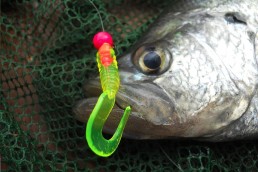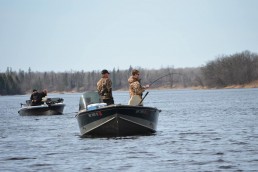SHARE THIS POST
If you fish walleyes in the Midwest, you’re familiar with two prime windows for chasing the biggest fish of the year. One focuses on the spring runs of pre-spawn walleyes in Great Lakes tributaries and in river systems like the Mississippi or the Rainy rivers. The other opportunity arrives late in the season as walleyes strap on the fall feed bag with anglers pursuing them shallow under the light of the full moon with trolling presentations or rigging giant chubs near deep structure during the day. These early- and late-season big-fish times provide an endless parade of pot-bellied walleyes.
If you missed out, you’ve got another chance to target them in June, a month that represents prime time for anglers. Large numbers of walleyes remain in relatively shallow water and are in abundance in cover like weeds, rock or timber. Food webs are exploding in both lakes and rivers now, putting walleyes in a positive feeding mood, making them available during the day and under the cover of darkness. There are two proven patterns to help unlock some of the fishing now and the chance to tangle with a trophy.
Catch them by day in weeds
If you’re not fishing in weeds in June you’re missing out. While sizable weed-walleye populations are present in most waters, they are especially prevalent in stocked lakes and reservoirs now. A lively leech dangling beneath a slip bobber near the deep weed edge works, but I prefer a more proactive, mobile approach that covers lots of territory and puts my presentation in front of more fish.
I love to pull spinners along the deep weed edges. Fishing spinners in weeds is fun, easy, and best of all, requires only the simplest of equipment. I tie my own spinner rigs using a 3-foot section of 10- or 12-pound- test fluorocarbon, which I favor because of its enhanced abrasion resistance and low-stretch characteristics. Snell a number 2 or 4 octopus hook onto one end of the fluorocarbon leader. Thread five red beads onto the leader and a plastic clevis for the spinner, and then one more chartreuse bead. Finally, tie a quality swivel onto the end of the leader, opposite the hook. Snap a number 3 hammered silver or gold Colorado spinner blade into the clevis. Your spinner rig is complete. I also use a braided main line to present my spinner rigs in the weeds. I thread a 1/4-ounce bullet sinker onto the braided line and tie the main line to the spinner rig’s swivel. Dress the hook with a large, lively leech, and you’re ready to fish.
Pulling spinners in weeds is a fast-paced, mobile presentation. Position your boat along the deep weed edge, often in 8 to 12 feet of water, but it can be much deeper in very clear lakes. Use a trolling motor to get your boat moving parallel to the weed edge and try to maintain a relatively consistent speed between 1.2 and 1.5 mph. Lob a long cast behind the boat and adjust the boat’s speed—or the length of line between the rod tip and the bait—until you feel the spinner occasionally deflect off the weeds. Using a long, sensitive spinning rod will help you to maintain control of the spinner rig and differentiate between snaggy weeds and hungry walleyes. When a strike occurs, drop the rod tip back toward the fish, wait a second or two to ensure that the fish has worked its way up to the hook, and then drive it home with a sweeping hook-set.
Are you enjoying this post?
You can be among the first to get the latest info on where to go, what to use and how to use it!
Head to shorelines at night
That weed-walleye bite will continue right up until dark. But by then I’ve generally put my spinners to bed in favor of my collection of shallow-running crankbaits. At the same time, I’ll move my boat away from the deep weed edge and head toward the shoreline. Many lakes feature a shoreline-related walleye bite until daytime water temperatures push 75 degrees. In June, when the water is still relatively cool, you can target walleyes under the cover of darkness just a few feet away from the shore.
Not all shorelines are created equally when it comes to attracting early-summer walleyes. I search for a relatively clean stretch of water, perhaps 50 to 60 feet wide, between the shoreline and a distinct inside weed edge. Bottom composition is important for creating this weed-free walleye zone, and a hard bottom like sand or gravel is preferred over a soft, mucky substrate. Water that is 3 to 4 feet deep in this zone is more than enough. And if there are a few downed trees, old stumps or a small rockpile or two in the area, nighttime walleyes are sure to be present. Side-imaging technology can also help you rapidly identify the hot spots.
Just like the daytime spinner presentation, my after-hours walleye trips are equally mobile and simple. I position my boat over the shallow, inside weed edges and use my trolling motor to slowly patrol parallel to the shoreline at speeds close to 0.5 mph. I’ll use the same long, sensitive spinning rod and sport the same braided main line to cast shallow-running crankbaits close to shore. Both shad- and minnow-profile baits can be effective in the 7- to 9-centimeter range, but as the water continues to warm this month, shad-bodied baits with a tight wiggle will be stronger performers. My retrieve is slow and steady, and I’ll work the entire weed-free walleye zone with extra effort made along docks, laydowns and any submerged structure. Shoreline walleyes are there to feed, and will generally alert you to their presence with the savage strikes to your crankbaits. If you’ve never tangled with an aggressive walleye in the shallows when water temperatures are in the 70s, you’re in for a real treat.
June represents a time of abundance for walleye anglers. You’ll have lots of opportunities to tangle with large numbers as well as oversized specimens. Apply these two patterns on your favorite lake, including pulling spinners along the deep weed edges during the day and casting crankbaits through weed-free zones along shorelines after dark. Enjoy it, because it won’t be warm, sandal-wearing weather on the water for the next prime-time walleye bite in fall.
Did you enjoy this post?
You can be among the first to get the latest info on where to go, what to use and how to use it!
MWO
We believe being outdoors is good. With more than 1,000 articles each year, MidWest Outdoors magazine is all about sharing outdoor experiences with you—where to go, what to use and how to use it… whether you’re close to home or on that trip of a lifetime.

